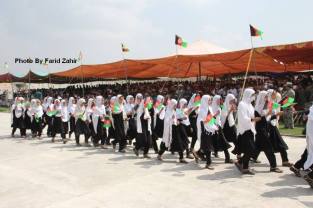Afghanistan, often called the crossroads of Central Asia, has a long history of turbulence. Based on archaeological evidence, urban civilization began in the region between 3000 and 2000 BC. The first historical documents date from the early part of the Iranian Achaemenian Dynasty, which controlled the area from 550 BC until 331 BC.
Between 331 and 327 BC, Alexander the Great defeated the Achaemenian emperor Darius III and squashed local resistance. Alexander and his successors, the Seleucids, brought Greek cultural influences to the region. Shortly thereafter, the Mauryan Empire of India gained control of southern Afghanistan, bringing with it Buddhism. In the mid-third century BC, nomadic Kushans established an empire that became a cultural and commercial center (60s–375 AD). From the end of the Kushan Empire in the third century AD until the seventh century, the region was fragmented and under the general protection of the Iranian Sassanian Empire.
In 642 AD, Arabs invaded the entire region and introduced Islam. Arab rule gave way to the Persians, who controlled the area until conquered by the Turkic Ghaznavids in 998. Following Mahmud’s short-lived dynasty, various princes attempted to rule sections of the country until the Mongol invasion of 1219, led by Genghis Khan. Following Genghis Khan’s death in 1227, a succession of petty chiefs and princes struggled for supremacy until late in the 14th century, when one of his descendants, Tamerlane, incorporated Afghanistan into his own vast Asian empire.
In 1747, Ahmad Shah Durrani unified the Pashtun tribes and created the Durrani Empire, which is considered the beginning of modern Afghanistan. In the late 19th century, Afghanistan became a buffer state buffer between the British Indian Empire and the Russian Empire. On August 19, 1919, following the third Anglo-Afghan war, the country regained full independence from the United Kingdom.
A brief foray into democracy ended in a 1973 coup and a 1978 Communist counter-coup. The Soviet Union invaded in 1979 to support the frail Afghan Communist regime, sparking a long and destructive war. The USSR withdrew in 1989 under relentless pressure from internationally supported anti-Communist mujahedin rebels. After a subsequent series of civil wars, in 1996 Kabul fell to the Taliban, a hard-line Pakistani-sponsored movement that emerged in 1994 to end the country’s civil war and anarchy. Following 2001 a US, Allied, and anti-Taliban Northern Alliance military action toppled the Taliban regime. The UN-sponsored Bonn Conference in 2001 established a process for political reconstruction that included the adoption of a new constitution.
In December 2004, Hamid Karzai became the first democratically elected president of Afghanistan. The National Assembly was inaugurated the following December. After winning a second term in 2009, Karzai’s presidency came to an end in 2014. The Afghanistan presidential election of 2014 was controversial, and despite UN supervision there were many allegations of fraud. After a second round of voting, the two frontrunners, Ashraf Ghani Ahmadzai and Abdullah Abdullah, came to a power-sharing agreement. Ghani will serve as the president. Despite gains toward building a stable central government, a resurgent Taliban and continuing provincial instability — particularly in the south and the east — remain serious challenges for the government of Afghanistan.



